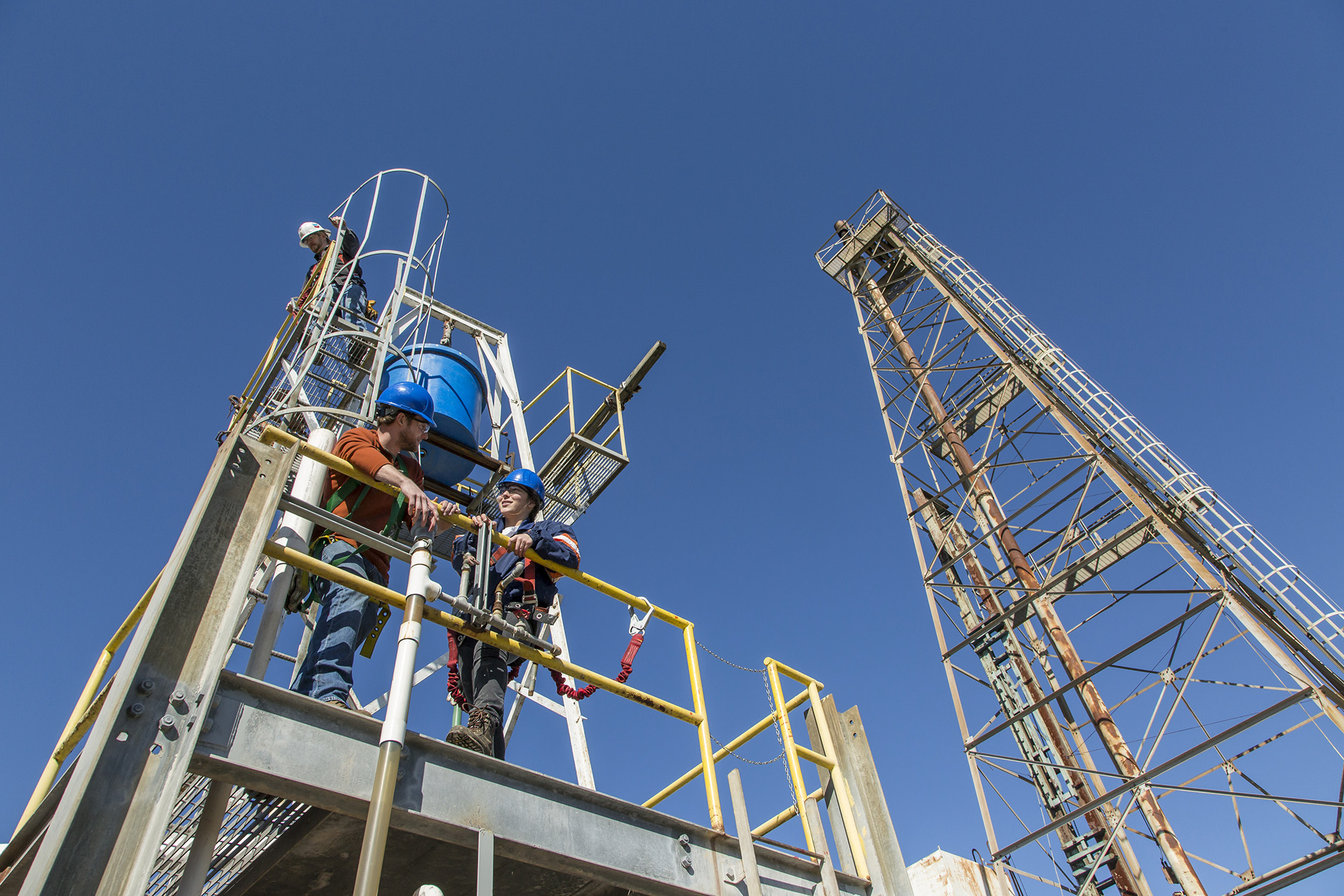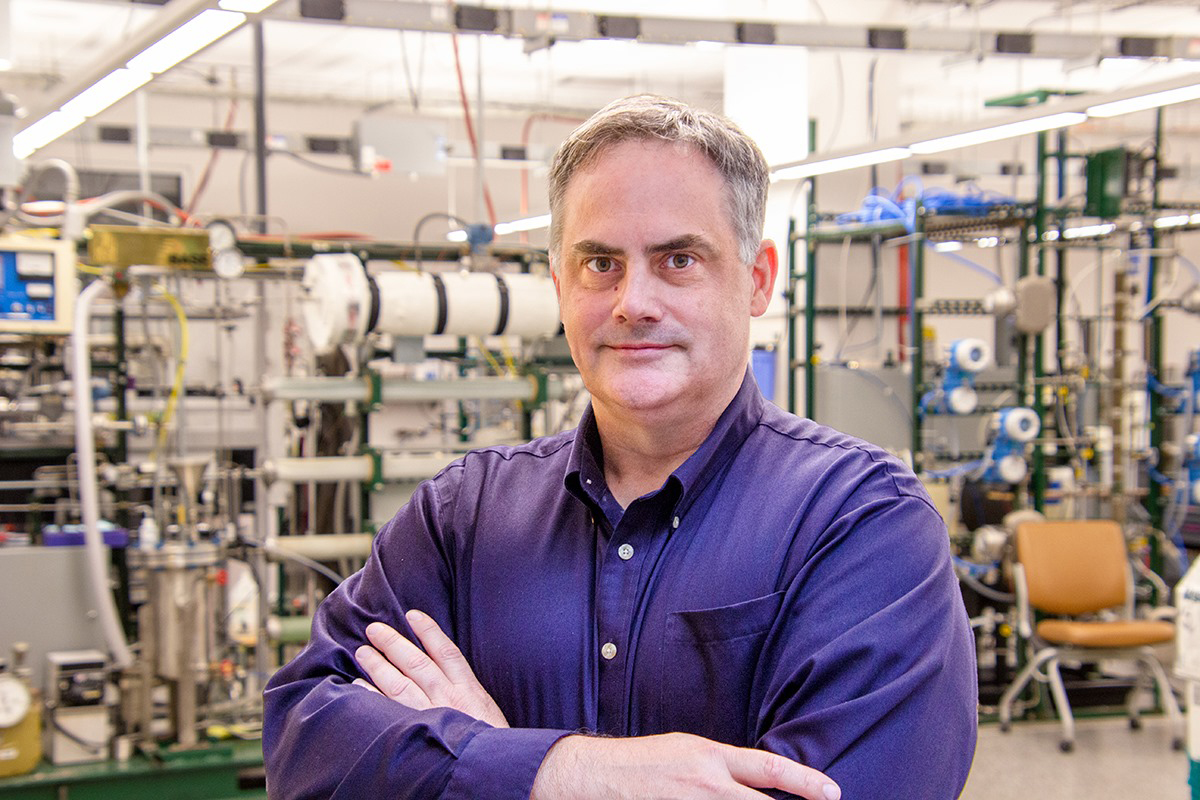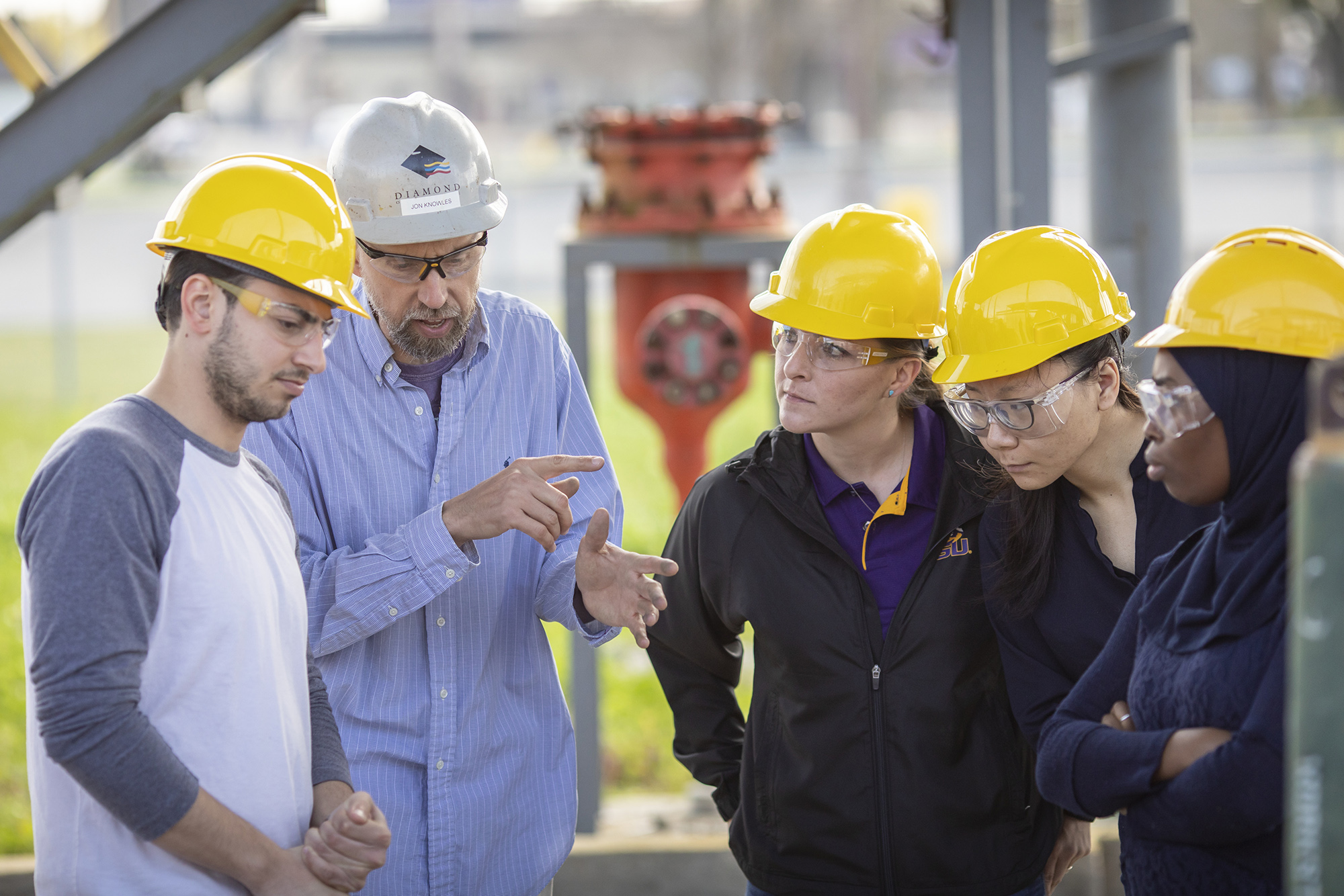Enabling Energy Development through Demonstration
LSU Momentum in Energy R&D Sparks Bold Approach to Advance Talent, Technology

Every third job in Louisiana is directly or indirectly linked to energy and chemical manufacturing. Like Louisiana’s generational oil and gas industry, LSU has an opportunity to repurpose its assets, including on-campus infrastructure like the PERTT Lab, to serve as innovative teaching and research environments to advance the energy transition focused around carbon capture and hydrogen production and use.
By building a platform to advance the energy transition across Louisiana, LSU is adding and reimagining one-of-a-kind campus infrastructure to create an environment for testing and demonstration of emerging technologies, position LSU and Louisiana for investment, help companies and the government tackle energy challenges at scale and inform through education and outreach at every step.
Last year’s catalytic investment by the state in carbon capture and hydrogen technology research and development at LSU was at the forefront of a cascade of commitments all aimed to elevate the ongoing energy transition for Louisiana and the nation. These commitments, guided by the new LSU Institute for Energy Innovation, are now connecting facilities and expertise across the LSU flagship campus in Baton Rouge. Coupling new investments to existing assets is transforming the physical campus into an integrated testbed for ideas. With this testbed, LSU will go beyond R&D to engage both industry and the public in RD&D—research, development and demonstration, with an increased focus on education, outreach and technology transfer.

Rhoman Hardy is the new interim director of the LSU Institute for Energy Innovation and former senior vice president at Shell where he helped plan the company’s future growth in low-carbon fuels, chemicals and carbon capture. “LSU will help the state develop the energy solutions the world needs to thrive,” he said.
“The energy transition is well underway with significant growth in renewable and lower-carbon products,” said Rhoman Hardy, interim director of the LSU Institute for Energy Innovation and former senior vice president at Shell where he helped plan the company’s future growth in low-carbon fuels, chemicals and carbon capture. “Louisiana will be key in the production of these new products and technologies. Supported by the LSU Institute for Energy Innovation, LSU will help the state develop the energy solutions the world needs to thrive.”
Following the $5 million in investment from the Louisiana Legislature last summer, LSU’s potential as an energy leader was further elevated by a $27.5 million gift from Shell that included $25 million in dedicated funding to establish the new LSU Institute for Energy Innovation. In alignment with LSU’s Scholarship First Agenda, the university was also able to bring together and join large public-private teams to pursue and secure federal funding, serving a key technological role in a $50M award from the U.S. Economic Development Administration, part of the $1 billion Build Back Better Regional Challenge, for the H2theFuture initiative. Led by GNO, Inc., H2theFuture is focused on the production and use of hydrogen, or H2, as a green fuel and workable alternative to oil and gas. LSU will serve as one of the testbeds for the project through newly established hydrogen and carbon demonstrations. This capacity in energy transition technology enabled LSU to lead a Regional Innovation Engines proposed innovation hub that is presently under review by the National Science Foundation.
The Challenge
While many large energy companies have committed to carbon neutrality by 2050, Louisiana continues to source about 84 percent of its energy from CO2-producing fossil fuels like oil and gas. Much due to its thriving, carbon-based chemical manufacturing industry, concentrated along the Mississippi River between Baton Rouge and New Orleans, Louisiana has the fourth-largest carbon footprint in the nation.

Louisiana State Senate Majority Leader Sharon Hewitt, a former Shell engineering executive and the industry’s primary advocate in the Louisiana Legislature, says the “critical work at LSU to develop new energy technologies will ensure energy security for the world and high-paying jobs here in Louisiana.”
But carbon itself isn’t bad. We need carbon to make detergents, packaging, insulation and cellphones, medical equipment and airbags. Preventing it—as CO2—from escaping into the atmosphere, or harnessing it directly from the air, is a core challenge. Enter carbon capture, the first step in preventing atmospheric CO2 emissions. Capture processes have been used for decades to remove CO2 from air in submarines or to separate CO2 byproducts in the manufacture of ammonia or ethylene oxide. The current challenge is to make the process more efficient in terms of capturing CO2 and reducing the energy required to do so. The separated CO2 then needs to be used or stored to avoid emissions.
This drives the need for pilot-scale tests that brings Louisiana’s leading energy companies, such as Shell, Dow and BASF, to the LSU Petroleum Engineering Research, Training & Testing, or PERTT, Lab. There, industry professionals can work together with faculty and students to solve critical challenges related to carbon capture, use and storage, or CCUS, which are key aspects of emissions reduction and the successful transition to H2.
“Louisiana, with help from our state’s flagship university, LSU, along with our industry partners, will continue to be a leader in energy production for the foreseeable future,” said Louisiana State Senate Majority Leader Sharon Hewitt, a former Shell engineering executive and the industry’s primary advocate in the Louisiana Legislature. “I am proud to have secured the state funding to initiate this critical work at LSU to develop new energy technologies that will ensure energy security for the world and high-paying jobs here in Louisiana.”
Adding and Reimagining Campus Infrastructure for RD&D

John Flake, professor of chemical engineering at LSU, develops more sustainable ways to continue to make and have carbon products without CO2 emissions: “For example, we can drive CO2-reduction reactions using electrical energy from non-CO2-emitting sources like solar instead of heat from fossil fuel combustion. This electrolytic manufacturing approach results in zero or even negative CO2 emissions when paired with direct air capture.”
Using the $5 million in state funding, LSU is now expanding the capabilities of the PERTT facility to include a new surface flowloop and wellbore specifically for CO2 RD&D. The new facilities will be constructed using CO2-compatible materials for high-pressure testing and outfitted with advanced instrumentation, including fiberoptic sensors. They will give students and industry a chance to test and refine emerging approaches, and the public—including hundreds of high school students—a chance to see the technologies in action and understand how they fit into the broader energy transition and enable innovation.
The funding from the state is also being used to purchase an electrolyzer, which splits water into oxygen and hydrogen. Hydrogen can be used as a non-carbon energy source and is used to produce ammonia, the primary component of fertilizer and an essential resource for agriculture for Louisiana and the nation’s farmers. LSU will also build its own CO2 electrolyzer, which will transform carbon dioxide and water into oxygen and products like ethylene, a basic building block for hundreds of common carbon-based products.
“Not all of the CO2 needs to be sequestered and stored,” said John Flake, professor of chemical engineering at LSU. “Some can be recycled and used to make carbon products. For example, we can drive CO2-reduction reactions using electrical energy from non-CO2-emitting sources like solar instead of heat from fossil fuel combustion. This electrolytic manufacturing approach results in zero or even negative CO2 emissions when paired with direct air capture. It’s a more sustainable way to continue to have carbon products without CO2 emissions.”

LSU is adding and reimagining on-campus infrastructure and connecting expertise in multiple disciplines to engage both industry and the public in energy transition RD&D—research and development (in lighter purple) to also include demonstration (in darker purple), with an increased focus on educational outreach and technology transfer. The larger dots in dark purple mark the locations of the PERTT Lab to the southwest and the Chemical Engineering Building toward the center of the flagship campus, as well as the Center for River Studies to the north along River Road on the Water Campus.
Solving Problems at Scale
These research facility and infrastructure improvements, with the flowloop and wellbore at the PERTT Lab and the electrolyzers going into the Chemical Engineering Building next to LSU’s power plant near Tiger Stadium, will not stand alone—they will be integrated into an energy talent and technology development platform. Like Louisiana’s generational oil and gas industry, LSU has an opportunity to repurpose its assets, including on-campus infrastructure, to serve as innovative teaching and research environments.
“For decades, LSU has been internationally known for research, testing and training in areas related to traditional oil and gas recovery, including blowout prevention,” said Karsten Thompson, chair and professor in the LSU Craft & Hawkins Department of Petroleum Engineering. “The new facilities being installed at the PERTT Lab will allow us to provide similar educational and R&D support for technologies associated with the energy transition, especially those related to subsurface CO2 storage.”
While the new flowloop will be used to study a wide range of aspects related to CO2 transport and material interactions, the new wellbore will be unique in its ability to provide a full-scale, highly instrumented prototype for testing tools and processes related to subsurface CO2 injection. LSU is currently seeking funds to add a capture system in the form of two columns, including an absorber and a stripper. The absorber pulls CO2 from sources, such as a flue gas—exhaust from an industrial stack or pipe, like from the LSU power plant—while the stripper then separates and concentrates the CO2, which either could be stored for use in the flowloop and wellbore, or brought to the CO2 electrolyzer for transformation into valuable carbon products right on LSU’s campus.
Connecting Disciplines

Karsten Thompson, chair and professor in the LSU Craft & Hawkins Department of Petroleum Engineering, says the new facilities being installed at the LSU PERTT Lab—a flowloop and new wellbore for CO2—“will allow us to provide educational and R&D support for energy transition technologies.”
By transforming LSU’s flagship campus into a platform for energy engagement and outreach, LSU will connect multiple partners with key expertise and supporting disciplines across the LSU system. Historically, oil and gas companies have found talent in petroleum engineering, but the energy transition requires a much broader perspective. Last fall, LSU became the first university in the nation to offer a formal concentration in CCUS. Currently, 17 students are enrolled in the concentration, with four expected to graduate this May.
Other disciplines that will be critical to the energy transition include geology and geophysics to explore long-term storage of CO2; chemistry to develop new solutions for direct air capture of CO2 and greener battery technologies to store energy from hydrogen and renewables; cybersecurity to protect critical energy infrastructure against attack; chemical engineering to transform water into hydrogen as well as CO2 into valuable carbon products; and mechanical and industrial engineering to develop efficient and safe hardware, including pumps, compressors and supercapacitors.
Around this core of science and engineering, LSU aligns critical support in both research and service, such as through the Center for Energy Studies for energy policy and economics to understand risks and opportunities; the Paul M. Hebert Law Center for energy law; sociology to study impacts on communities; and LSU Innovation Park for patenting and licensing solutions, thus enabling technology transfer between the university and its many partners.

With the new flowloop and wellbore at the PERTT Lab, LSU students will help companies and the government tackle energy transition challenges at scale.
Finally, and most importantly, LSU aims to engage communities statewide through education and outreach to enable adoption of new technologies and share new knowledge on energy transition impacts and opportunities.
“Energy and chemical facilities in Louisiana propel our economy, with every third job directly or indirectly connected to energy and chemical manufacturing,” Hardy said. “LSU has a strong legacy working with major producers and will continue to grow these partnerships as companies explore new pathways for energy and lower-carbon products in a rapidly evolving landscape.”
Read more:
LSU First to Offer CCUS Concentration (LSU Engineering)
LSU to Play Major Role in CO2 Capture, Utilization and Sequestration (LSU Engineering)
Putting the Carbon Genie to Work (LSU Office of Research & Economic Development)
LSU PETE Professor Proposes Plan for Orphan Oil Wells (LSU Engineering)
Plaisance Receives Prestigious DOE Early Career Award (LSU Engineering)
LSU, Delaware to Develop Chemical Manufacturing Processes Using CO2 Feedstocks and Renewable Energy (LSU Engineering)
LSU Chemical Engineering Faculty Researching Means of Decreasing Greenhouse Gases (LSU Engineering)


